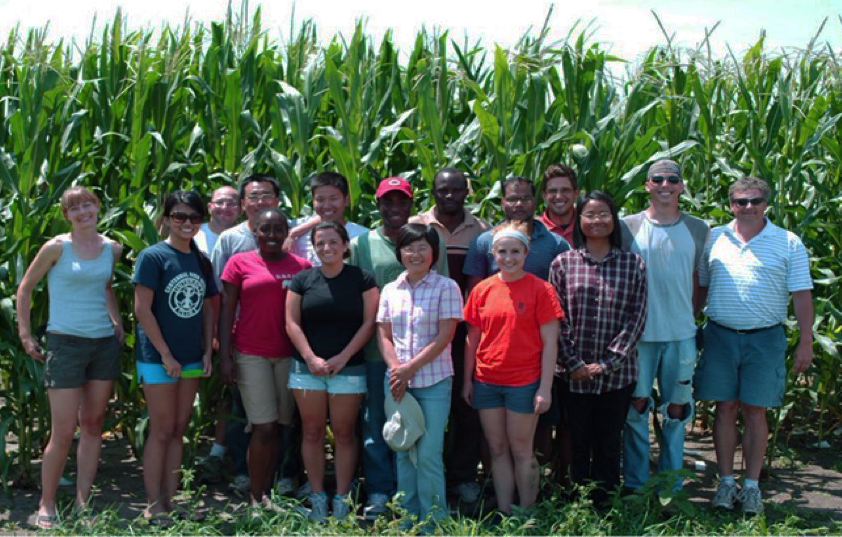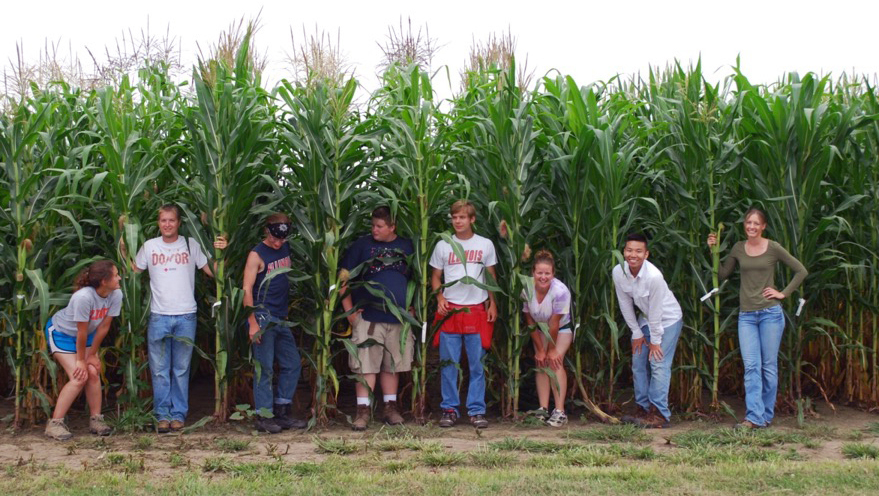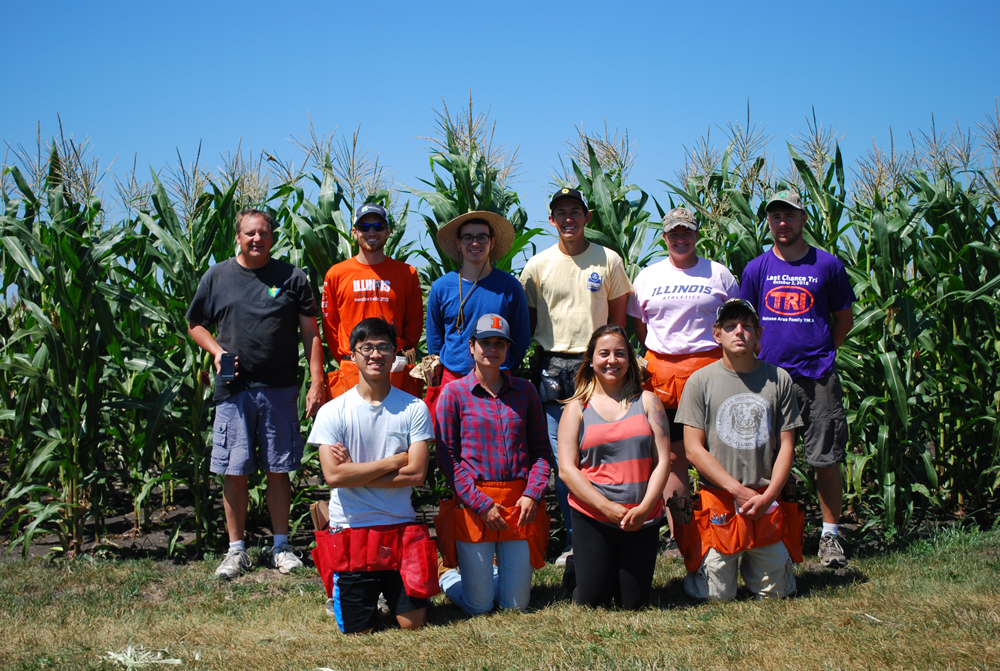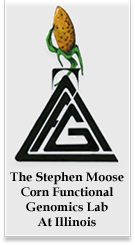Research Efforts:
 The Moose lab is a research group that operates within the Crop Sciences Department of the University of Illinois at Urbana-Champaign. We apply functional genomic approaches to characterize genes that modulate productivity and sustainability in maize and also closely related crop species: sorghum, Miscanthus, and sugarcane. Each of these grasses within the Andropogoneae tribe perform highly productive C4 photosynthesis. They are important global sources of food, feed, bioenergy, and renewable biochemicals. These grasses also share a high degree of similarity in their genome and complementary advantages in the study of economically important traits. Maize is our primary focus because of its advanced tools for relating genes to phenotype.
The Moose lab is a research group that operates within the Crop Sciences Department of the University of Illinois at Urbana-Champaign. We apply functional genomic approaches to characterize genes that modulate productivity and sustainability in maize and also closely related crop species: sorghum, Miscanthus, and sugarcane. Each of these grasses within the Andropogoneae tribe perform highly productive C4 photosynthesis. They are important global sources of food, feed, bioenergy, and renewable biochemicals. These grasses also share a high degree of similarity in their genome and complementary advantages in the study of economically important traits. Maize is our primary focus because of its advanced tools for relating genes to phenotype.
The Illinois Long-term Selection Experiment:
Our lab is well-known for maintaining the world’s longest running continuous genetics experiment in higher plants. The Illinois Long Term Selection Experiment (ILTSE) was originally started in 1896 by Cyril G. Hopkins. Since then, over 800 cycles of selection have been produced from the same source population. The experiment began by selecting for four extremes ultimately producing the Illinois High Protein (IHP), Illinois Low Protein (ILP), Illinois High Oil (IHO), and Illinois Low Oil (ILO). From these populations, we have the opportunity to better understand evolutionary change, regulatory variation, and the complex genetic basis for the phenotypic changes observed in this experiment.
Discovery of Genes Controlling Nitrogen Utilization:
 High crop yields in modern intensive agriculture depend on sufficient levels of available soil nitrogen (N) provided by N fertilizer. Corn and other cereals can typically use only one-third to one-half of applied N fertilizer resulting in higher inputs to the farmer as well as increased greenhouse gas emissions and leached nitrate in water supplies. Thus, improving nitrogen use efficiency in corn would offer significant benefits to agriculture. Prior agronomic studies have established that increasing the amount of biomass produced per unit of plant nitrogen (N utilization) offers the greatest potential for genetic improvement of nitrogen use efficiency in maize (Moose and Below, 2008). To better understand this trait, we have documented phenotypic variation for N utilization in diverse maize populations (e.g. Uribelarrea et al., 2007; White et al., 2012; Ayodeji et al., 2012). This study is assisted by the Illinois Protein Strains having been selected for changes in grain protein and N utilization for over a century (Lucas and Moose, 2012). Recent work in maize hybrids has identified a number of genes that regulate N utilization, and further testing is in progress. We are also beginning to expand our research to sorghum, an emerging annual bioenergy crop, and Miscanthus. Since perennial grasses require less N for maximal biomass production, learning how Miscanthus achieves higher N utilization may be useful for applications in other cereal crops like maize.
High crop yields in modern intensive agriculture depend on sufficient levels of available soil nitrogen (N) provided by N fertilizer. Corn and other cereals can typically use only one-third to one-half of applied N fertilizer resulting in higher inputs to the farmer as well as increased greenhouse gas emissions and leached nitrate in water supplies. Thus, improving nitrogen use efficiency in corn would offer significant benefits to agriculture. Prior agronomic studies have established that increasing the amount of biomass produced per unit of plant nitrogen (N utilization) offers the greatest potential for genetic improvement of nitrogen use efficiency in maize (Moose and Below, 2008). To better understand this trait, we have documented phenotypic variation for N utilization in diverse maize populations (e.g. Uribelarrea et al., 2007; White et al., 2012; Ayodeji et al., 2012). This study is assisted by the Illinois Protein Strains having been selected for changes in grain protein and N utilization for over a century (Lucas and Moose, 2012). Recent work in maize hybrids has identified a number of genes that regulate N utilization, and further testing is in progress. We are also beginning to expand our research to sorghum, an emerging annual bioenergy crop, and Miscanthus. Since perennial grasses require less N for maximal biomass production, learning how Miscanthus achieves higher N utilization may be useful for applications in other cereal crops like maize.
Regulatory Impacts of Small RNAs on Plant Growth and Development:
Small RNAs play important roles in regulating plant development, stress response, viral immunity and maintaining genome integrity. Most studies of small RNAs have focused on microRNAs that regulate protein coding genes comparable to when we found that microRNA172 is a key regulator of shoot maturation in maize, by downregulating the maize Glossy15 gene that maintains vegetative development (Lauter et al., 2005). However, most plant small RNAs are derived from transposons, “jumping genes”, that are present in many interspersed copies forming the majority of plant genomes. We have recently used deep sequencing methods to monitor variation in the activities of transposon-derived small RNAs and how they impact hybrid vigor, the greater growth and stress tolerance of progeny produced from crosses of genetically diverse parents (Barber et al., 2012 and Li et al., 2012).
The Structure and Function of the Miscanthus Genome:
Complete genome sequences exist for the annual crops maize and sorghum, but are lacking for the related perennials Miscanthus and Saccharum (sugarcane, energy cane). With the support of the Energy Biosciences Institute, we are working to develop genomic resources for Miscanthus. We have determined the content and activity of transposon repeat sequences in Miscanthus (Swaminathan et al., 2010) which also established Sorghum as a valuable reference genome for both Miscanthus and Saccharum (Wang et al., 2010). When we constructed a complete genetic map for Miscanthus sinensis (Swaminathan et al., 2012), it was discovered that the Miscanthus genome arose via a recent whole genome duplication of a Sorghum-like genome. In addition to this work, our lab reported an analysis of the majority of expressed genes within Miscanthus (Barling et al., 2013), including those that function in the rhizome tissue important for perenniality. Our group is now focused on producing an assembled genome sequence for Miscanthus sinenis.

